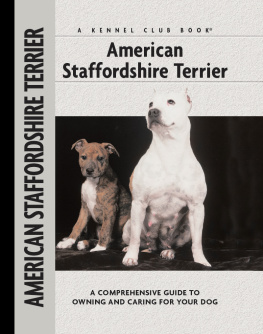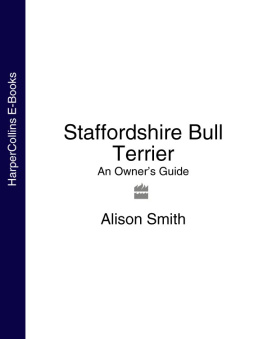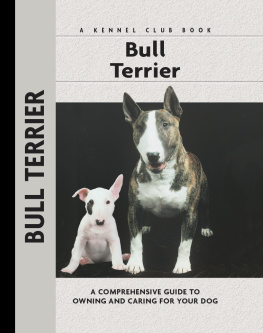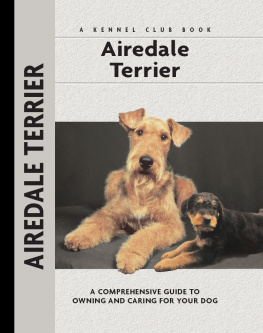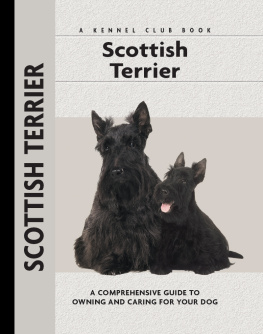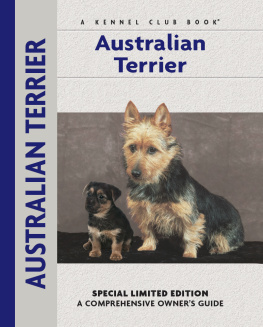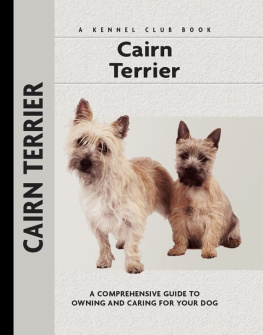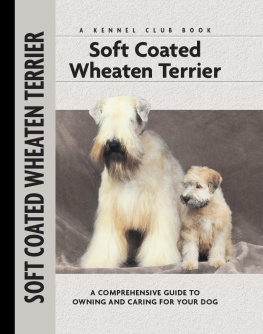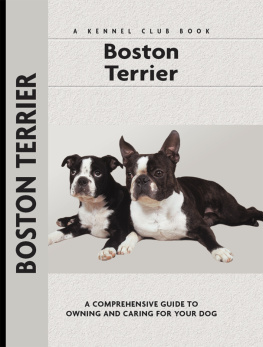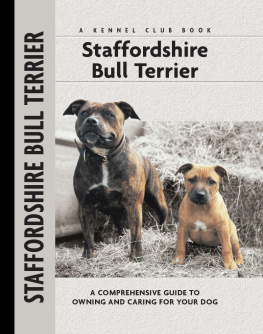Physical Characteristics of the American Staffordshire Terrier
(from the American Kennel Club breed standard)
Head: Medium length, deep through, broad skull, very pronounced cheek muscles, distinct stop.
Ears: Cropped or uncropped, the latter preferred.
Eyes: Dark and round, low down in skull and set far apart.

Nose: Definitely black.
Neck: Heavy, slightly arched, tapering from shoulders to back of skull.
Muzzle: Medium length, rounded on upper side to fall away abruptly below eyes.
Jaws: Well defined.
Lips: Close and even, no looseness.
Shoulders: Strong and muscular with blades wide and sloping.
Body: Well-sprung ribs, deep in rear. Forelegs set rather wide apart to permit chest development.
Chest: Deep and broad.
Legs: The front legs should be straight, large or round bones, pastern upright.
Feet: Moderate size, well-arched and compact.
Back: Fairly short. Slight sloping from withers to rump with gentle short slope at rump to base of tail. Loins slightly tucked.
Tail: Short in comparison to size, low set, tapering to a fine point.
Coat: Short, close, stiff to the touch, and glossy.
Color: Any color, solid, parti, or patched is permissible.
Hindquarters: Well-muscled, let down at hocks.
Size: Height and weight should be in proportion. A height of about 18 to 19 inches at shoulders for the male and 17 to 18 inches for the female is to be considered preferable.

Contents

From fighting dog to farmhand to pet, follow the AmStaffs evolution from the mastiff, bulldog and terrier breeds in its ancestry and find out what makes him a wonderful all-around dog, despite the controversy that can be associated with the breed.

Pride, strength and loyalty are just a few of the AmStaffs positive qualities. Add in intelligence, versatility and affection toward people, and you have a well-rounded dog that makes a wonderful addition to the right family. Learn about the AmStaffs personality and physical traits, as well as what type of owner is ideal.

Learn the requirements of a well-bred American Staffordshire Terrier by studying the description of the breed set forth in the American Kennel Club standard. Both show dogs and pets must possess key characteristics as outlined in the breed standard.

Find out about how to locate a well-bred American Staffordshire Terrier puppy. Discover which questions to ask the breeder and what to expect when visiting the litter. Prepare for your puppy shopping spree. Also discussed are home safety, the first trip to the vet, socialization and solving basic puppy problems.

Cover the specifics of taking care of your American Staffordshire Terrier every day: feeding for the puppy, adult and senior dog; grooming, including coat care, ears, eyes, nails and bathing; and exercise needs for your dog. Also discussed are the essentials of dog identification.

Begin with the basics of training the puppy and adult dog. Learn the principles of house-training the AmStaff, including the use of crates and basic scent instincts. Enter Puppy Kindergarten and introduce the pup to his collar and leash and progress to the basic commands. Find out about obedience classes and other activities.

By Lowell Ackerman DVM, DACVD
Become your dogs healthcare advocate and a well-educated canine keeper. Select a skilled and able veterinarian. Discuss pet insurance, vaccinations and infectious diseases, the neuter/spay decision and a sensible, effective plan for parasite control, including fleas, ticks and worms.

Know when to consider your American Staffordshire Terrier a senior and what special needs he will have. Learn to recognize the signs of aging in terms of physical and behavioral traits and what your vet can do to optimize your dogs golden years.

Step into the center ring and find out about the American Kennel Clubs system of showing pure-bred dogs. Heres how to get started in AKC shows, how they are organized and whats required for your dog to become a champion.

Analyze the canine mind to understand what makes your American Staffordshire Terrier tick. Among the potential problems addressed are aggression (fear-biting, inter-canine and dominant), separation anxiety, chewing, digging and jumping up.
K ENNEL C LUB B OOKS
A MERICAN S TAFFORDSHIRE T ERRIER
ISBN 13: 978-1-59378-248-1
eISBN 13: 978-1-59378-983-1
Copyright 2004 Kennel Club Books An Imprint of I-5 Press A Division of I-5 Publishing, LLC
3 Burroughs, Irvine, CA 92618 USA
Cover Design Patented: US 6,435,559 B2 Printed in South Korea
All rights reserved. No part of this book may be reproduced in any form, by photostat, scanner, microfilm, xerography or any other means, or incorporated into any information retrieval system, electronic or mechanical, without the written permission of the copyright owner.
Photography by:
Paulette Braun, T.J. Calhoun, Alan and Sandy Carey, Kent & Donna Dannen, Isabelle Franais, Tony George, Carol Ann Johnson, Bill Jonas, Nikki Sussman and Wil de Veer.
Illustrations by Rene Low and Patricia Peters.
Special thanks to the owners & breeders of dogs featured in this book: V. D. Broek, J. Duval, Tony George, Cindy Gerritsen, Peter & Ingrid Gppel, Frans Herzig, Beth Jones, Rachel Kruidenier, B. Ockhuizen, W. Ruisch, Max van Slijpe, Steffie van Slijpe, R. Snip, Joe Terrazas, Wil de Veer, Denine Vooris, John Willett, Janine M. Wolf and Tonny van Zantvliet.

Behind the impressive musculature and iron determination of the American Staffordshire Terrier flows the blood of mastiffs of 3,000 years ago.

How can a dog possibly be so perfect? One must look to the development of the breed, which begins as long ago as 800 BC, when Phoenician traders first brought to England a strain of mastiff from Asia. The original mastiffs were bred to bring down, fight or hold large and aggressive prey such as wild boars, bears or big catsanimals that are as likely to fight as to run away. Ancient mastiffs had incredible fighting ability and courage and were highly prized throughout Asia and Europe.
Next page
